Friday, December 28, 1928
Still here. Xmas morning I climbed into the parade dress and went to the Scottish Presbyterian Church where I sang all the hymns. After the service the Rev. I. BrownSmith [perhaps Rev. John Brown Smith, St. Andrew’s Presbyterian Church] and his wife invited me to coffee the following evening. Returning to the hotel, I opened my presents and mail. My check and 25 extra clinkers from Mother and Dad, and a big box of cookies, candy, figs, and stuffed dates. Also an Xmas tree and a stocking full of candy. Dudie sent 5 berries and Dick Huggard a dandy pocket-knife. Jean’s box was a surprise. Some plenty good-looking golf socks from her; a nice pair of gloves from Bobby, something I have been too dumb to buy for myself for the last two or three months and much needed, even here, in the winter. Deedie Mama sent me some pretty handkerchiefs. Had a letter and card from Grandmother Mac, a letter from Dad, Eleanor, and Bob Lewis and a card from Harry Fitzgerald, Sis Sullivan, and Frances Huggard. And such mushy cards!!! Lots of devilment going on in Columbus and something rotten in Denmark besides.
 For lunch the same 7-course endurance test and for dinner soup, eggs, fish, steak, french frieds, peas, turkey, boiled spuds, coffee, and cake and cakes. In the afternoon I walked around a bit. The soldiers were having a good time and many were all dressed up in crazy costumes. I took a picture of a couple, talked a while, and went on, soon to meet a soldier and sailor who saw my kodak and wanted their picture taken. Both had indulged too heavily in Xmas cheer and were so comical that I crashed through with a picture. The soldier was very talkative and was going to do lots for me. Wanted to show me through the hospital. Said I would be unexpected but welcome. I couldn’t let him be so kind to me, though.
For lunch the same 7-course endurance test and for dinner soup, eggs, fish, steak, french frieds, peas, turkey, boiled spuds, coffee, and cake and cakes. In the afternoon I walked around a bit. The soldiers were having a good time and many were all dressed up in crazy costumes. I took a picture of a couple, talked a while, and went on, soon to meet a soldier and sailor who saw my kodak and wanted their picture taken. Both had indulged too heavily in Xmas cheer and were so comical that I crashed through with a picture. The soldier was very talkative and was going to do lots for me. Wanted to show me through the hospital. Said I would be unexpected but welcome. I couldn’t let him be so kind to me, though.
In the evening and all through the night it was more like Halloween. Gangs parading up and down the street yelling and singing. Lots of street fights, etc. They have an affair here they use to make noise and accompany their singing that isn’t at all musical, but it is not unpleasant to hear. Sounds something like a primitive war drum. It is a clay urn, but instead of the regular bottom, one of a parchment membrane through which a slender bamboo stick is worked up and down like a piston. [It’s called a zambomba.] The day was nice and a little cloudy.
Wednesday most everything was closed so I spent most of the day on the other side of this big razor-back and on the beach. In the eve I went out for coffee. Had a very nice visit.
Thursday morning I went up to the Lower Galleries with a guide from the hotel. Guides are required. The lower galleries don’t take you far up, but that is all that is permitted. The walk is practically all through a big tunnel cut through the solid rock in 1789 and thereabouts. The tunnel leads up at a fairly steep angle. At intervals are holes through to the outside for the guns. Only a few old ancient guns are in this part now to appease the many tourists. But 400 soldiers are at Gibraltar now and somewhere in the rock is a supply of food sufficient to withstand a siege of ten years.
On my way back, I stopped to see the American Consul, Mr. Sprague. He is very nice and called up a passenger line to see if I could get a job, but n.g. I then went to several agencies and shipping companies, but not much luck. I could have had 3rd-class passage to Port Said on a passenger boat for £11, but it is too much. Most of the freights want £22 to £25 to Alexandria 1st or 2nd class. One line has a deck passage for a little over £4 to Alexandria and if I can’t get a job or do better, I’ll probably take that. I will have to wait, though, till about the middle of January. Deck passage promises to be lots of fun, especially if it is cold or rainy. Have to live on the deck for ten days and carry your own food. One stop en route, at Malta in four or five days.
At three I took a boat for Tangiers and arrived after dark at six-fifteen. Got in a good hotel, English, for 8 pesetas dinner and breakfast. The Hotel Cavilleon on the Big Market. Took a walk before dinner. Started into one of these darned mosques but only got inside the outside door for everybody in the shops across the busy street yelled at me. At dinner I met a Mrs. Sammet of Boston who has been traveling about alone for nearly a year, 59 years old and as lively as a kid.
Tangiers is a complete change from Europe in about everything. It is made up of English, French, Spanish, Moors, Bèrberians, Negro slaves, Jews, and about everything. All languages are spoken there, all money used,, dollars, pounds, francs, pesetas, and Moorish coins. The streets are very narrow, twisty, quite dirty, and very busy. Life is decidedly Oriental. Most of the natives wear the flowing white robes, many the brown or black robes, all the hood over the head. Few wear stockings, just sandals and bare legs. Turbans or red Turk hats on their heads and lots of beards. The women are all in the robes too. Some in the higher classes wear the drapes across their faces. The little crowded shops that line the narrow ways are full of goods and curios. Many oriental bazaars have lots of beautiful things to sell, but they ask plenty. In the little coffee dens you can see the natives all sitting around on the floor in a circle, legs crossed, sipping coffee and smoking long pipes. You can look in at many shops and watch them work, making jewelry, sewing, etc. The little dirty kids are all over and the small donkeys do overtime on big heavy loads. There are lots of beggars. Even the kids beg, turn flips, do acrobatic stunts, and then pester you for money. The Moors are too lazy to work much and this accounts for lots of begging. Some parts of town are distinctly Moorish, others Spanish, and others English. In the market square the natives have their stuff spread on the ground before where they are sitting. At night, and Thursday is a big market day, they all sell by the light of the little lamps or coal-oil jets placed on the ground. The whole thing looks like a big witch scene and those in white robes like so many ghosts moving about. A wonderful moon came up over the bay and Spanish Morocco. It was so bright that it was like day, and from my window overlooking the market-place I could see all the city bathed in the moonlight, the white houses, buildings, and churches standing out very distinctly—and all of those white figures moving about below. The inside downstairs of the hotel was in Moorish style and one room especially in which were lots of interesting and pretty things.
 Today Mrs. Sammet showed me about the city; the Alcazar where a fake sultan and harem are living to help poor innocent tourists see the sights of oriental life. The place is far from striking and has only the Moorish style to take it from the ordinary. The old fortress is the scene of a former battle and I believe the Battle of Trafalgar was fought just off this coast. There are several mosques. The men step inside the outside door (as far as I got). In stepping over this step they leave their sandals on the outside, turn, pick them up and walk in barefooted. Thus I suppose I committed a crime by entering the threshold in my boots.
Today Mrs. Sammet showed me about the city; the Alcazar where a fake sultan and harem are living to help poor innocent tourists see the sights of oriental life. The place is far from striking and has only the Moorish style to take it from the ordinary. The old fortress is the scene of a former battle and I believe the Battle of Trafalgar was fought just off this coast. There are several mosques. The men step inside the outside door (as far as I got). In stepping over this step they leave their sandals on the outside, turn, pick them up and walk in barefooted. Thus I suppose I committed a crime by entering the threshold in my boots.
As today was Friday—their Sunday—many shops were closed. We went in one that was open to buy a leather cushion cover I wanted to send Mother. They have some beautiful patchwork in leather and all done by hand. Talk about salesmanship and jewing down. I took a fancy to a leather cover and the Moor asked, I believe, 35 pesetas or nearly $6 for it. We said too much and I offered him 20. He came down to 30. Well, it went on for nearly 15 minutes. I stood fast and Mrs. Sammet was right with me. He thought he was talking it up by calling it common leather and we promptly hopped on him and told him it was no good. They have plenty of time and like to talk. When he was down to 23 pesetas, I gave him 20 and the blue leather was mine, $3.20, and a real bargain at that price. As Lucy would say, “Je l’ai pour rien.”
At 11 AM the boat weighed anchor under a cloudy sky. The wind from the Atlantic was pretty cold. From the bay the city is very picturesque. It is built on a sloping hill and you can see the white houses all over the town rising one above the other. Three hours later I again was in Gibraltar. No mail today, though I had a letter from Harry Fitz Thursday.
The next thing was to cut my 9s per on hotel and meals. After talking to the manager, we cut it to 6s per, but with only lunch which is the biggest meal. I have a hunch the hotel will also furnish about enough for another meal a day but doesn’t know it. Now, with expenses at $1.50 a day, I can live here and save a little while I wait for a job or boat passage to Alexandria.
 We dock at Marseille at 6AM. After wandering all over the poor section of town, as I always manage to do, I found the good part. Only walked past the American Express Co. four times before I saw it but that is just like a man, I guess, so I’m excused. Got a letter from Dad, Mother, Lippy, Jean (2), Hory, and a paper with the glad tidings of Ind[iana]’s defeat by [Ohio] State, and last but not least, the funny paper.
We dock at Marseille at 6AM. After wandering all over the poor section of town, as I always manage to do, I found the good part. Only walked past the American Express Co. four times before I saw it but that is just like a man, I guess, so I’m excused. Got a letter from Dad, Mother, Lippy, Jean (2), Hory, and a paper with the glad tidings of Ind[iana]’s defeat by [Ohio] State, and last but not least, the funny paper.
 Saturday I was again up before dawn and left Toulon at 6:30 AM. Hadn’t gone far before it began to rain but I had to keep on to get my Spanish visa before noon. It was strange how those gentle hills could go up at a steep pace for five straight miles. I was getting all wet when a man in a Ford truck, who had stopped on the road a moment to take a drink, offered to give me a lift—but not a drink. I gladly accepted. It was at the top of a hill and he took me about six miles, all downhill, but I was out of the rain. I rode the last ten, but the rain had ceased. It was nice and cold and I felt like an ad for the North Pole.
Saturday I was again up before dawn and left Toulon at 6:30 AM. Hadn’t gone far before it began to rain but I had to keep on to get my Spanish visa before noon. It was strange how those gentle hills could go up at a steep pace for five straight miles. I was getting all wet when a man in a Ford truck, who had stopped on the road a moment to take a drink, offered to give me a lift—but not a drink. I gladly accepted. It was at the top of a hill and he took me about six miles, all downhill, but I was out of the rain. I rode the last ten, but the rain had ceased. It was nice and cold and I felt like an ad for the North Pole.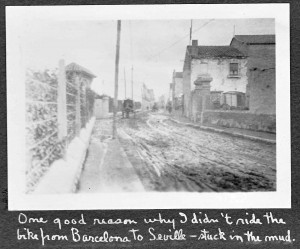
 Barcelona is a very pretty city. In its heart is the large Plaza de la Cataluña with its gardens, statues and chairs and benches. There are many wide beautiful boulevards and richly ornamented buildings. Some are very bizarre, one especially, having no definite lines. [Certainly the
Barcelona is a very pretty city. In its heart is the large Plaza de la Cataluña with its gardens, statues and chairs and benches. There are many wide beautiful boulevards and richly ornamented buildings. Some are very bizarre, one especially, having no definite lines. [Certainly the 

 Near the good-looking station is the Toros, three stories high, round, and of red brick. I bought some food for lunch and ate it inside the place while watching some men play around practicing bull-fighting. That night at 8:50 PM I was again off on a long journey, this time to Madrid, 16 hours. I was on deck early and got a good seat in a car that had
Near the good-looking station is the Toros, three stories high, round, and of red brick. I bought some food for lunch and ate it inside the place while watching some men play around practicing bull-fighting. That night at 8:50 PM I was again off on a long journey, this time to Madrid, 16 hours. I was on deck early and got a good seat in a car that had  The large Parque de Madrid is very nice. In it is a huge monument erected to Alfonso XII, facing a pretty lake. The Toros in Madrid is similar to that in Valencia though slightly larger. The Senate is an imposing building and was, on the evening I left, surrounded for a couple of blocks each way by many cops. The King was probably in there. The
The large Parque de Madrid is very nice. In it is a huge monument erected to Alfonso XII, facing a pretty lake. The Toros in Madrid is similar to that in Valencia though slightly larger. The Senate is an imposing building and was, on the evening I left, surrounded for a couple of blocks each way by many cops. The King was probably in there. The  This country is very unlike that near Madrid. This city is on a great plain, 2,500 feet above sea level, with the Sierra de Guadaramas a few miles to the north. At the border, financial setback No. 2. I tried to get the duty back for my bike. At first they wouldn’t listen to me about it. Next they said the Duanes was not open on Sunday. We argued around for several minutes till somebody got a gentleman out of the train who lived in South Africa and could speak English. Then we could get more understanding. They finally said I only had a receipt for money paid and not an order to pay back the duty. The only thing to do was to go on and see the American Consul at Lisbon. No. 3 came in now. As I was the only 3rd passenger left, they dropped that car. Maybe they do it anyway. The result was that I had to finish 2nd class and the difference I had to pay was about $1.50. I was sure fed up by this time! I decided right then and there to wage war on everything.
This country is very unlike that near Madrid. This city is on a great plain, 2,500 feet above sea level, with the Sierra de Guadaramas a few miles to the north. At the border, financial setback No. 2. I tried to get the duty back for my bike. At first they wouldn’t listen to me about it. Next they said the Duanes was not open on Sunday. We argued around for several minutes till somebody got a gentleman out of the train who lived in South Africa and could speak English. Then we could get more understanding. They finally said I only had a receipt for money paid and not an order to pay back the duty. The only thing to do was to go on and see the American Consul at Lisbon. No. 3 came in now. As I was the only 3rd passenger left, they dropped that car. Maybe they do it anyway. The result was that I had to finish 2nd class and the difference I had to pay was about $1.50. I was sure fed up by this time! I decided right then and there to wage war on everything.
 the American Vice-Consul about it and he had a big laugh. Seems as though here they go in for dark colors, mostly black; lots of black capes, etc. When I came parading down the Rua with my nice light knickers on and fancy socks, they all thought I was crazy and didn’t conceal the fact. Guess most of them never saw any such things before anyway. It was funny for a while but then got to be a pain. They would stop to watch me pass. If walking in front, would slow up to walk behind me. If a group were talking on a corner, they would all turn around and look at me like I was nuts. Lots would smile and some laugh. Gosh, what dumb people over here! $2.39.
the American Vice-Consul about it and he had a big laugh. Seems as though here they go in for dark colors, mostly black; lots of black capes, etc. When I came parading down the Rua with my nice light knickers on and fancy socks, they all thought I was crazy and didn’t conceal the fact. Guess most of them never saw any such things before anyway. It was funny for a while but then got to be a pain. They would stop to watch me pass. If walking in front, would slow up to walk behind me. If a group were talking on a corner, they would all turn around and look at me like I was nuts. Lots would smile and some laugh. Gosh, what dumb people over here! $2.39.
 After lunch I went to the American Consulate where I had a nice long talk with the Vice Consul, who is a dandy young fellow. He said they could do nothing to get my duty back on my bike. It seems to be a bad habit in Spain to collect duties and not give them back. He told me of a theatrical troupe which had paid several hundred dollars in duties which they were not able to recover. He also said the same thing would probably happen in Portugal. Thus the cheapest thing for me to do is to forget my bike and leave it here. A pretty darned lowdown dirty practice I calls it and hard on a thin pocketbook. I’ll make it up along the line somewhere. Hope it is in Spain. I’m going to write some Spaniard a mouthful—don’t know who it will be yet, but he’ll get my opinion of his country and Spaniards in general and particular. Next I went to the British Consulate where it took me an hour and three-quarters to get a visa for Egypt—and 220 escudos or about $10.75. That’s hard to take too. The English Consul or Vice Consul, whatever he was, was a nice chap, very English and therefore very interesting. It was five before I left there. Next I went to Wagon-Lits to get the dope on how to get to Seville, not trusting Cook’s. I have two ways to go. The cheaper is by a train, taking some 22 hours I believe. I think I’ll leave here Wednesday night, travel all day Thursday, reaching Seville in the evening, stay there two days, take a bus to Gibraltar Sunday and so be there the 24th. Another fortune shot.
After lunch I went to the American Consulate where I had a nice long talk with the Vice Consul, who is a dandy young fellow. He said they could do nothing to get my duty back on my bike. It seems to be a bad habit in Spain to collect duties and not give them back. He told me of a theatrical troupe which had paid several hundred dollars in duties which they were not able to recover. He also said the same thing would probably happen in Portugal. Thus the cheapest thing for me to do is to forget my bike and leave it here. A pretty darned lowdown dirty practice I calls it and hard on a thin pocketbook. I’ll make it up along the line somewhere. Hope it is in Spain. I’m going to write some Spaniard a mouthful—don’t know who it will be yet, but he’ll get my opinion of his country and Spaniards in general and particular. Next I went to the British Consulate where it took me an hour and three-quarters to get a visa for Egypt—and 220 escudos or about $10.75. That’s hard to take too. The English Consul or Vice Consul, whatever he was, was a nice chap, very English and therefore very interesting. It was five before I left there. Next I went to Wagon-Lits to get the dope on how to get to Seville, not trusting Cook’s. I have two ways to go. The cheaper is by a train, taking some 22 hours I believe. I think I’ll leave here Wednesday night, travel all day Thursday, reaching Seville in the evening, stay there two days, take a bus to Gibraltar Sunday and so be there the 24th. Another fortune shot.



 Returning to the Condessa’s house (only once getting lost on the way) I arrived just as she was returning from her meeting. We had an enjoyable tea, talked of travels, language, and some of her Russian friends, princes, etc. At 6:30 I left to take the Express back to Lisboa where I changed my outfit; and now here I am one hour out from Lisbon and 21 more to go to Seville. Thank goodness the train isn’t crowded. Same old hard seats and cold, though!! $7.80.
Returning to the Condessa’s house (only once getting lost on the way) I arrived just as she was returning from her meeting. We had an enjoyable tea, talked of travels, language, and some of her Russian friends, princes, etc. At 6:30 I left to take the Express back to Lisboa where I changed my outfit; and now here I am one hour out from Lisbon and 21 more to go to Seville. Thank goodness the train isn’t crowded. Same old hard seats and cold, though!! $7.80.

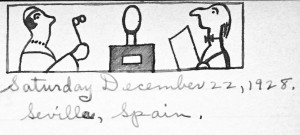 At three I met del Arco and he showed me about the maze of streets. First some fine mosaics in the court of a countess. Then the home of the
At three I met del Arco and he showed me about the maze of streets. First some fine mosaics in the court of a countess. Then the home of the 
 ‘Twas the night before Xmas, and all thru the hotel, not a creature was stirring, only little Hally who was hanging his socks up—but not for Santa. Tonight is the big clean-up night. Got the 6 o’clock bus in plenty of time this morning. The first two hours were cold ones. About 9/10 of the road was n.g., but the bus tore right along, doing about 200 miles in 6¼ hours. At first the country was a broad, rolling prairie, partly cultivated and much used for sheep and cattle grazing. As we got farther south, it became very hilly, almost mountainous, and the rocks, close to the surface, cropped out in many places, making the country look rather rugged and desolate on the whole. This region is but thinly settled. In Algeciras there was a wait of an hour for the boat. It is right across the bay from Gibraltar and you can get an excellent view of the big rock. To your right as you cross the bay looms a mountainous coast, Spanish Morocco. Landing, the herd of hotel agents descended. I had to take pension rates to get a hotel—$2.25 a day. It’s a good hotel, though, and as cheap as I can get here, so Cook’s says. We’ll call it an Xmas treat. They don’t miss feeding you. About 6 courses of everything under the sub. But they’ll sure lose money feeding me.
‘Twas the night before Xmas, and all thru the hotel, not a creature was stirring, only little Hally who was hanging his socks up—but not for Santa. Tonight is the big clean-up night. Got the 6 o’clock bus in plenty of time this morning. The first two hours were cold ones. About 9/10 of the road was n.g., but the bus tore right along, doing about 200 miles in 6¼ hours. At first the country was a broad, rolling prairie, partly cultivated and much used for sheep and cattle grazing. As we got farther south, it became very hilly, almost mountainous, and the rocks, close to the surface, cropped out in many places, making the country look rather rugged and desolate on the whole. This region is but thinly settled. In Algeciras there was a wait of an hour for the boat. It is right across the bay from Gibraltar and you can get an excellent view of the big rock. To your right as you cross the bay looms a mountainous coast, Spanish Morocco. Landing, the herd of hotel agents descended. I had to take pension rates to get a hotel—$2.25 a day. It’s a good hotel, though, and as cheap as I can get here, so Cook’s says. We’ll call it an Xmas treat. They don’t miss feeding you. About 6 courses of everything under the sub. But they’ll sure lose money feeding me. Gibraltar isn’t a bad city and is certainly a lively one. The sailors and soldiers seem to be having the biggest time. Dancing with each other in the cafés, half tipsy, all singing and yelling. I can hear them singing and raising the roof of some joint right now.
Gibraltar isn’t a bad city and is certainly a lively one. The sailors and soldiers seem to be having the biggest time. Dancing with each other in the cafés, half tipsy, all singing and yelling. I can hear them singing and raising the roof of some joint right now.
 For lunch the same 7-course endurance test and for dinner soup, eggs, fish, steak, french frieds, peas, turkey, boiled spuds, coffee, and cake and cakes. In the afternoon I walked around a bit. The soldiers were having a good time and many were all dressed up in crazy costumes. I took a picture of a couple, talked a while, and went on, soon to meet a soldier and sailor who saw my kodak and wanted their picture taken. Both had indulged too heavily in Xmas cheer and were so comical that I crashed through with a picture. The soldier was very talkative and was going to do lots for me. Wanted to show me through the hospital. Said I would be unexpected but welcome. I couldn’t let him be so kind to me, though.
For lunch the same 7-course endurance test and for dinner soup, eggs, fish, steak, french frieds, peas, turkey, boiled spuds, coffee, and cake and cakes. In the afternoon I walked around a bit. The soldiers were having a good time and many were all dressed up in crazy costumes. I took a picture of a couple, talked a while, and went on, soon to meet a soldier and sailor who saw my kodak and wanted their picture taken. Both had indulged too heavily in Xmas cheer and were so comical that I crashed through with a picture. The soldier was very talkative and was going to do lots for me. Wanted to show me through the hospital. Said I would be unexpected but welcome. I couldn’t let him be so kind to me, though.
 Today Mrs. Sammet showed me about the city; the Alcazar where a fake sultan and harem are living to help poor innocent tourists see the sights of oriental life. The place is far from striking and has only the Moorish style to take it from the ordinary. The old fortress is the scene of a former battle and I believe the
Today Mrs. Sammet showed me about the city; the Alcazar where a fake sultan and harem are living to help poor innocent tourists see the sights of oriental life. The place is far from striking and has only the Moorish style to take it from the ordinary. The old fortress is the scene of a former battle and I believe the 
 After my lunch—
After my lunch—

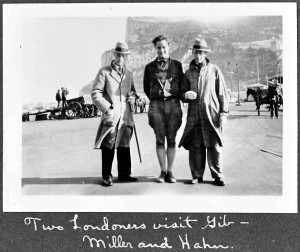 9PM—Same day, third chapter. Met two men who were American and traveling about some, one an architect. The other has been living in Edinburgh for about 2–3 years, and both from San Francisco. It was a glorious day and I showed them around, through Irish Town to the Southern point near the
9PM—Same day, third chapter. Met two men who were American and traveling about some, one an architect. The other has been living in Edinburgh for about 2–3 years, and both from San Francisco. It was a glorious day and I showed them around, through Irish Town to the Southern point near the 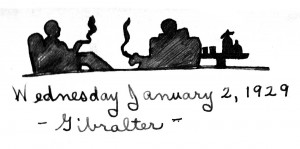 The book I was reading last night,
The book I was reading last night, 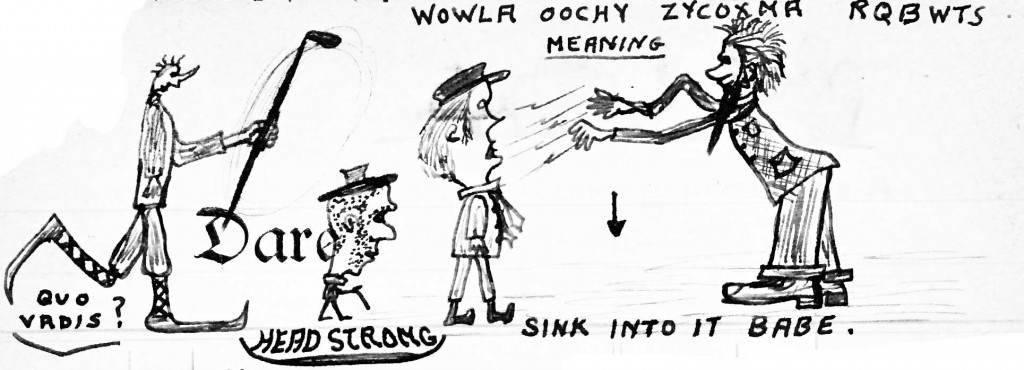 He proves the world was not made of nothing, but something, and states that the Creator is a real substance or being, possessing personal identity, and is infinite in every perfection of his character. But then he says electricity, which he regards as the primal form of matter, is an emanation from Spirit, Gods. God, then, must be of a more primal form; or is he the motion, function, property of this primal matter? If so, he is not mind—a cause—but an effect; otherwise, spirit is wholly distinct from matter of every form.
He proves the world was not made of nothing, but something, and states that the Creator is a real substance or being, possessing personal identity, and is infinite in every perfection of his character. But then he says electricity, which he regards as the primal form of matter, is an emanation from Spirit, Gods. God, then, must be of a more primal form; or is he the motion, function, property of this primal matter? If so, he is not mind—a cause—but an effect; otherwise, spirit is wholly distinct from matter of every form.
 10:45PM The wind died in its tracks today, for the most part, and the result was a splendid day. I spent the morning along the east coast of the Rock and in the afternoon played washerwoman for a while. Mail n.g. for 8 days. Had a very delightful time this evening at dinner with Mr. and Mrs. Yarde and another gentleman whose name I did not get. Mrs. Yarde is a very pleasant hostess. Mr. Yarde and the other man were very humorous. The former is quite a photographer and is going to send some pictures and an article to get [National] Geographic magazine to try to get it in—about Southern Spain, the cork industry. He showed me the pictures and they are really good. The other gentleman is going to take me to the top of the Rock tomorrow, stopping for lunch at Mrs. Yarde’s on the way. The people here are surely kind and hospitable. Flivvers may stop, hearts may flop, but school goes on forever. The second quarter at OSU isn’t any exception, either.
10:45PM The wind died in its tracks today, for the most part, and the result was a splendid day. I spent the morning along the east coast of the Rock and in the afternoon played washerwoman for a while. Mail n.g. for 8 days. Had a very delightful time this evening at dinner with Mr. and Mrs. Yarde and another gentleman whose name I did not get. Mrs. Yarde is a very pleasant hostess. Mr. Yarde and the other man were very humorous. The former is quite a photographer and is going to send some pictures and an article to get [National] Geographic magazine to try to get it in—about Southern Spain, the cork industry. He showed me the pictures and they are really good. The other gentleman is going to take me to the top of the Rock tomorrow, stopping for lunch at Mrs. Yarde’s on the way. The people here are surely kind and hospitable. Flivvers may stop, hearts may flop, but school goes on forever. The second quarter at OSU isn’t any exception, either.
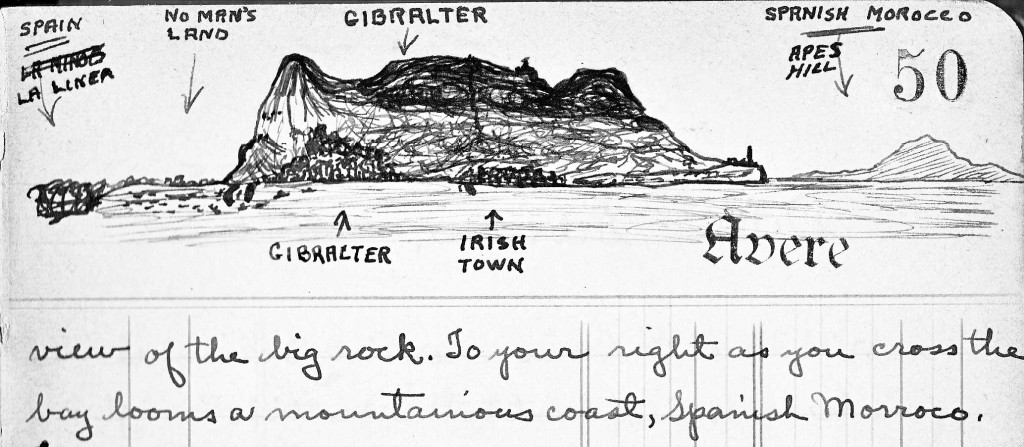



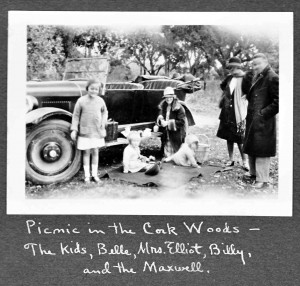
 Read late last night, so got up late today. Bought myself some white shorts for Egypt if it is warm enough. In the afternoon took a ride with the Baileys, my nieces and nephew, and Mr. Yarde whose birthday it is. Went to another place in the Cork Woods, had tea and a real good time. At noon Mrs. Yarde called up and said that Sir and Lady Nettleton had invited me to a party tomorrow afternoon. I am going with Mr. Merrick—dressed as a pirate—as near as knickers, loud socks, my skean dhu and les moustaches can make me look like one, and whatever Mrs. Yarde has to add. I know I’ll be a hot number. Sir Nettleton is the judge in Gibraltar.
Read late last night, so got up late today. Bought myself some white shorts for Egypt if it is warm enough. In the afternoon took a ride with the Baileys, my nieces and nephew, and Mr. Yarde whose birthday it is. Went to another place in the Cork Woods, had tea and a real good time. At noon Mrs. Yarde called up and said that Sir and Lady Nettleton had invited me to a party tomorrow afternoon. I am going with Mr. Merrick—dressed as a pirate—as near as knickers, loud socks, my skean dhu and les moustaches can make me look like one, and whatever Mrs. Yarde has to add. I know I’ll be a hot number. Sir Nettleton is the judge in Gibraltar.



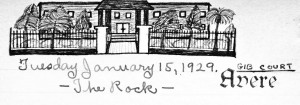
 Today was another of those nice sunny days that make the bay and the hills of Spain seem as though they were painted. All morning I was on the go, figuring expenses and getting dope on a trip to Greece and Turkey via Malta. I finally decided no, but went around to see the Captain anyway. He wasn’t in but had told the agent he wouldn’t take me deck. I’ll have to get that Friday boat whether the Captain wants me or not. I have lots of good ideas as to where I am going in the next few months and what I will do in Egypt and Palestine. Rumor hath it there will be a little walking connected with my visit. I’ll have to build up a big reserve for I’ll need it along about the middle of March.
Today was another of those nice sunny days that make the bay and the hills of Spain seem as though they were painted. All morning I was on the go, figuring expenses and getting dope on a trip to Greece and Turkey via Malta. I finally decided no, but went around to see the Captain anyway. He wasn’t in but had told the agent he wouldn’t take me deck. I’ll have to get that Friday boat whether the Captain wants me or not. I have lots of good ideas as to where I am going in the next few months and what I will do in Egypt and Palestine. Rumor hath it there will be a little walking connected with my visit. I’ll have to build up a big reserve for I’ll need it along about the middle of March.

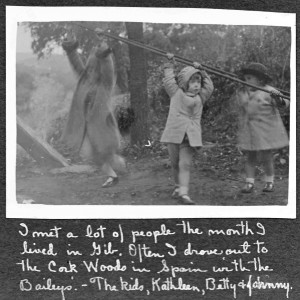
 Sure had worse luck heaped on already rotten luck today. The Captain of the
Sure had worse luck heaped on already rotten luck today. The Captain of the 

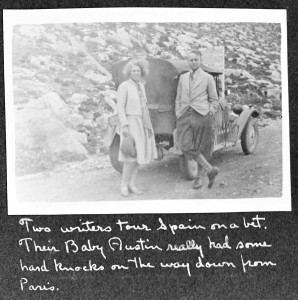
 I had retired late Thursday, so when my steward brought me tea at 6:30 or 7, I was still sleepy. Wisely he leaves the light on, though, so you can’t go to sleep again. The boat was rolling and pitching a good bit and I had much difficulty in keeping on my feet while shaving. The tea and I didn’t get along together at all. I went on deck. We were heading into a driving gale of wind which whipped icy sprays across the deck. I was very cold and it was next to impossible to stand in the wind. I would hate to be a bum sailor this late in the game so I played it safe, as I left a little unsettled, and flopped on my bunk. When I awoke it was 9:30, so I went on deck, glad I had refused breakfast. The sun was out and I stood in a sheltered place talking to a boy from just south of Edinburgh till we were in the harbor at 10:30AM. Scotch isn’t so easy to understand. The weather, two bob, and the fact that I had already seen Toulon kept me from going ashore. Didn’t do a whole lot all day, but read astronomy and spent the evening in my cabin with Jim Speight, of near Preston, England, bound for Sydney, who had been ashore exercising French words with the help of my dictionary. He is a dandy boy, 23, and a joiner and mechanic. The evening was beautiful. The moon, nearly full, over the bay, the lights of the city along the distant shore far below the black towering hills in the background. I wrote a letter to Bob Bruce and some on Jean’s and Dad’s and didn’t turn in till pretty late. One boy of 21 has got in with the wrong crowd on the boat and is dead drunk every night. He was drunk ashore and last night he fell down the 15 or so stairs outside my cabin. Some fool.
I had retired late Thursday, so when my steward brought me tea at 6:30 or 7, I was still sleepy. Wisely he leaves the light on, though, so you can’t go to sleep again. The boat was rolling and pitching a good bit and I had much difficulty in keeping on my feet while shaving. The tea and I didn’t get along together at all. I went on deck. We were heading into a driving gale of wind which whipped icy sprays across the deck. I was very cold and it was next to impossible to stand in the wind. I would hate to be a bum sailor this late in the game so I played it safe, as I left a little unsettled, and flopped on my bunk. When I awoke it was 9:30, so I went on deck, glad I had refused breakfast. The sun was out and I stood in a sheltered place talking to a boy from just south of Edinburgh till we were in the harbor at 10:30AM. Scotch isn’t so easy to understand. The weather, two bob, and the fact that I had already seen Toulon kept me from going ashore. Didn’t do a whole lot all day, but read astronomy and spent the evening in my cabin with Jim Speight, of near Preston, England, bound for Sydney, who had been ashore exercising French words with the help of my dictionary. He is a dandy boy, 23, and a joiner and mechanic. The evening was beautiful. The moon, nearly full, over the bay, the lights of the city along the distant shore far below the black towering hills in the background. I wrote a letter to Bob Bruce and some on Jean’s and Dad’s and didn’t turn in till pretty late. One boy of 21 has got in with the wrong crowd on the boat and is dead drunk every night. He was drunk ashore and last night he fell down the 15 or so stairs outside my cabin. Some fool.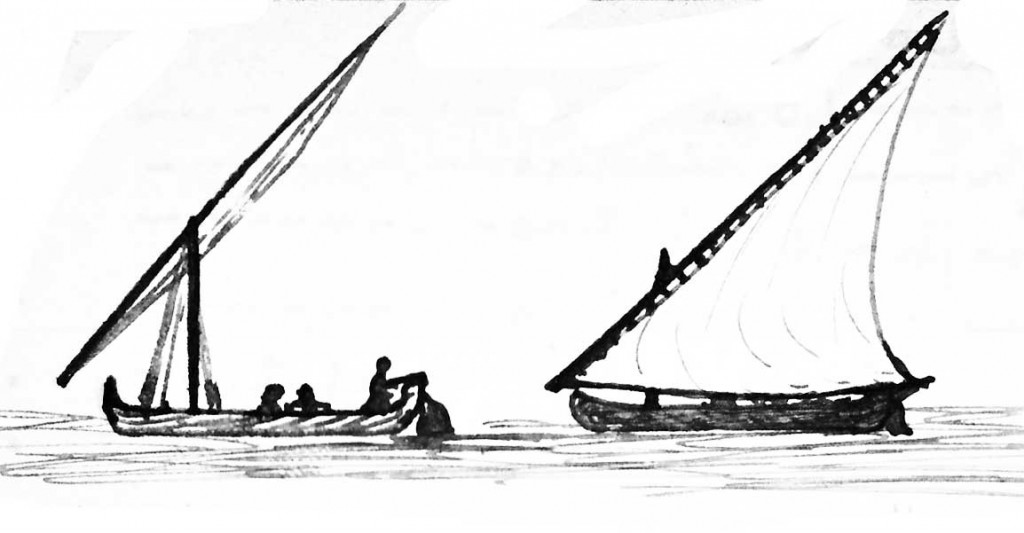
 Outside of a very strong, cool east wind, the day has been perfect. We sighted land about 9:30AM and by twelve were slowly entering the canal by the city. At the canal’s entrance is a large monument to
Outside of a very strong, cool east wind, the day has been perfect. We sighted land about 9:30AM and by twelve were slowly entering the canal by the city. At the canal’s entrance is a large monument to 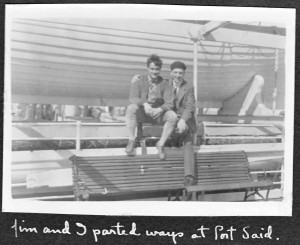


 I spent the morning inquiring about cargo vessels to Bombay. At noon I left for Cairo. The train, road, and canal followed side-by-side for many miles with a great expanse of low mudflats on either side. At
I spent the morning inquiring about cargo vessels to Bombay. At noon I left for Cairo. The train, road, and canal followed side-by-side for many miles with a great expanse of low mudflats on either side. At 
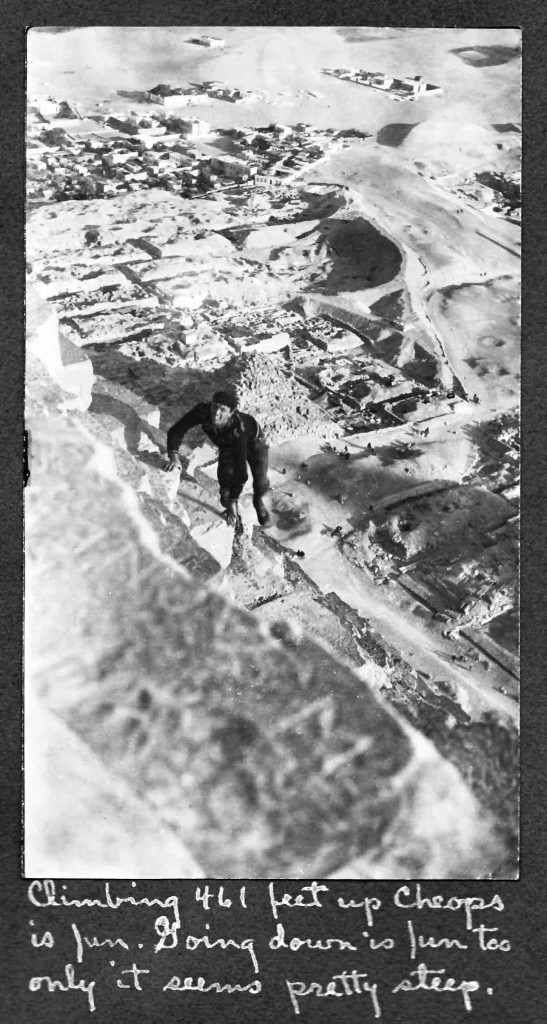 I started to climb
I started to climb  Next we descended a long steep tunnel some 200 feet or more to a very low tunnel full of dust where I nearly had to crawl. At the end was the
Next we descended a long steep tunnel some 200 feet or more to a very low tunnel full of dust where I nearly had to crawl. At the end was the 
 From 11:30 to 3, I spent in the native quarters. Wending my way through the narrow, crooked maze of passages and streets, I at last arrived at the foot of the Mahommed Ali
From 11:30 to 3, I spent in the native quarters. Wending my way through the narrow, crooked maze of passages and streets, I at last arrived at the foot of the Mahommed Ali 


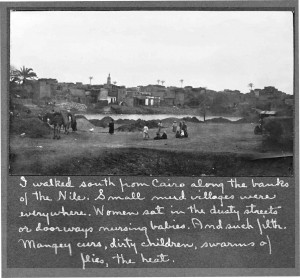 mud villages in the fertile narrow strip near the
mud villages in the fertile narrow strip near the  statue of Ramses II, knocked down in the 8th century and now resting on its back. Nearby a sphinx, not so large and much worn.
statue of Ramses II, knocked down in the 8th century and now resting on its back. Nearby a sphinx, not so large and much worn.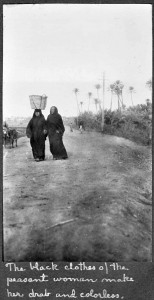 worse than a Scotchman. Walked 25 miles to save from 30 to 60 cents and would have walked the other 15 to save the two bits, but my feet were hurting. I wouldn’t trade it for anything, though. It was the best way of seeing how the country people
worse than a Scotchman. Walked 25 miles to save from 30 to 60 cents and would have walked the other 15 to save the two bits, but my feet were hurting. I wouldn’t trade it for anything, though. It was the best way of seeing how the country people 

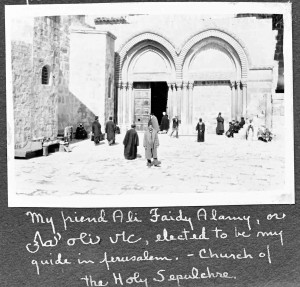 perhaps a few small square holes in the roof for light.
perhaps a few small square holes in the roof for light.